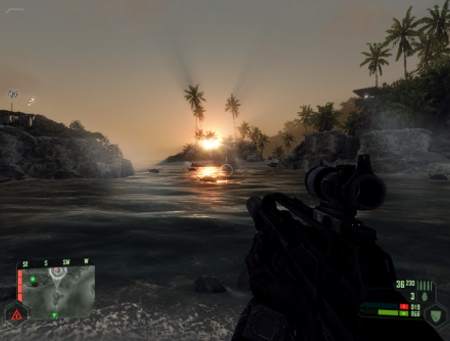Superior AI and next-gen interaction
TG Daily recently spoke with Neal Robison, AMD’s director of global ISV relations. During a wide-ranging interview, Robison reminisced about the classic gaming days and described his vision of the industry’s future.
TG Daily: What are some of your favorite, classic games? Do they include Doom, Duke Nukem, Wolfenstein, Starflight 2, The Secret of Monkey Island, Master of Orion, Sim City, Warcraft, Civilization and Age of Empires?

Robison: “Classic is relative to when you started gaming. Those are all certainly great titles. However, my all time favorite is Mario Kart 64. True, it is a console game, not PC, but I felt that it was the pinnacle of gaming – in terms of striking the right balance – when I was growing up. Of course, on the PC side, it was definitely Age of Empires, Age of Empires II, Doom and Starcraft. Those were just pinnacles in terms of the gaming experience.”
TG Daily: Would it be fair to say that Quake and Unreal set the standards for future FPS titles in terms of AI (third party bots/mods), graphics and multiplayer capabilities?
Robison: “Yes, those titles did set the standard and there are many gameplay elements that have yet to move forward since Quake and Unreal. Now, that can be both good and bad. For example, the FPS cadence – or pace – and single player AI are absolutely brilliant concepts that deserve to be part of FPS games today.
“But, at the same time, aside from graphics, there hasn’t been a significant number of innovative gameplay elements that pushed beyond the boundaries. Of course, this could be because the gamer audience has grown all too comfortable with the current state of things and don’t want their world to change. Or, perhaps it is because the industry hasn’t spent enough time and effort pushing those boundaries forward.”
TG Daily: How would you answer critics who claim the current generation of FPS games are nothing more than next-gen variations of the Unreal engine?
Robison: “It is normal human behavior to try and classify something based on a known standard. But look at Crysis – the developers really tried hard to push beyond the boundaries of a typical FPS. I guess the real question is: why has the Crysis team made a huge effort but not others?
“Well, financial freedom is a big part of the business, meaning, the marketplace is somewhat constrained by ‘hit driven’ industry standards and sales projections. As such, only a small, finite number of developers have the financial wherewithal to experiment and deliver beyond what is considered safe.

“For example, look at the relationship between Crytek and EA. The latter company had the financial ability to allow Crytek to experiment with various methods of gameplay and digital distribution. We’ll definitely want to see more of that moving forward, whether with Steam or Microsoft Xbox Live.”
TG Daily: Can you discuss some short-term improvements goals that you would like to see in the gaming world?
Robison: “Yes. Undoubtedly, in terms of both PC and console gaming, new methods of digital distribution will definitely play a major role in helping to reduce the daunting retail mountain that developers are often forced to climb.
“The iPhone model is a good example. Apple opened up a huge world of gaming and made it easier to get the product to customers. In addition, the very reasonable price point means that people can experiment without significant investment.
“It is also important to realize that the gaming market is cyclical and closely mirrors the process of consolidation experienced by the film industry. There is something of a monolithic structure that is constantly being challenged by a number of indie game developers.”
TG Daily: And long term goals?
Robison: “In the long term, AMD/ATI would like to help facilitate improved collaboration between the film and video game industries. For example, movies have incredible visual fidelity, but provide little more than a passive experience for the consumer. In contrast, video games offer the user a chance to interact with a virtual world on a number of levels.
“Yes, people have talked about this before, but there really is a huge opportunity to blend and mesh the two worlds. Move the special effects to the gaming world and extend the capabilities of the film industry by adding an interactive format or element.”

TG Daily: How will AMD/ATI help the game industry jump to the next level?
Robison: “Well, the GPU can be leveraged to improve both graphics and AI/pathfinding. Remember, AI, or pathfinding, can help make or break the single-player experience. We are hearing from developers that they are definitely looking ahead and are no longer content with AI that is just good enough. However, I must say that I really enjoyed playing games like Fallout 3 and Elder Scrolls: Oblivion. Both titles offered a rich and deep experience, in terms of the AI and the virtual world the developers created.
“I would also like to note that combining the full potential of the GPU and CPU is an exciting concept to me personally and will, of course, enable a new generation of games. Indeed, things are currently quite exciting for developers – with OpenCL and DirectCompute opening a world of technology in ways that we couldn’t even imagine before.”
See Also
Report: Sony eyes multi-core CPU for PS4
Thief shopped by stolen Xbox
Modder auctions Xbox 360 laptop on eBay
Epic runs Unreal 3 Engine on iPhone 3GS
Mom calls cops over son’s gaming addiction
Van Halen jumps on the Guitar Hero bandwagon?







